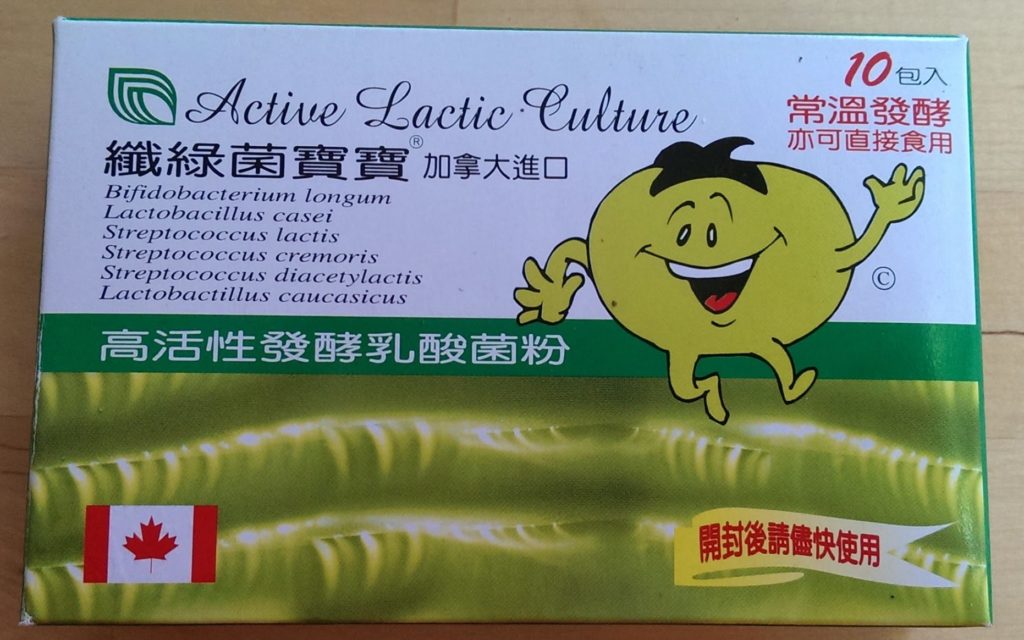It’s really easy to make and doesn’t require any cooking skills at all.
What you need is:
- 1 litre of milk
- 1 sachet of the Active Lactic Culture powder
- A clean container that fits the milk
You could actually put the powder into a milk carton or bottle, but it’s hard to check if it’s ready of you do this. I use a semi-clear drinking bottle with a wide opening. Pour the milk in, it doesn’t seem to matter if it’s cold or room temperature and there’s no need to bring it up a high heat as with yogurt. It might take a little bit longer if it’s cold, but that’s about it. Add the sachet of Active Lactic Culture powde, shake gently and leave outside in a warm (not hot) place for 12-16h, although the instructions say up to 24-36h if it’s cold, but I’ve never had to leave mine for more than about 16h. When finished, the top of the milk should be set, kind of like yogurt, now move the container carefully into the fridge, don’t shake it, as that seems to make it lumpy. Let it cool down for 2-3h and then you can shake it up. The texture should be like thick drinking yogurt and it should have a fresh smell. If it smells funky, then something went wrong in the process and I had this happen to me once. The good thing is that just as with yogurt, you can use what you’ve just made as a base for making more. Add 2-3 table spoons to 1 litre of milk for your next batch and repeat the rest of the steps above.
The package I bought looked like this and it’s made by this company Unfortunately they seem to have gone bust and I haven’t been able to find an alternative.

Hi, thanks for this very interesting recipe. I was looking to make Ragsiktskakor and the recipe asks for filmjolk. As I’m in Spain, I was wondering if the active lactic culturre you talk about would be the same you could get to make yoghurt. Thanks.
All best,
Bea
Well, Rågsiktskakor first of all requires sifted rye flour which is then mixed 40/60 with plain wheat flour. I don’t know if you can get that in Spain, but it can be done on your own, it just won’t be exactly the same as the premixed flour in Sweden. You could use yoghurt instead of filmjölk, but it might be a bit trial and error. Same goes for something like quark which I guess you could use as well. Something a bit acidic is used because it brings out the taste of the rye (syrup in case of the recipe below, as it’s more than just sweet) so you could use half a teaspoon of vinegar as well, but be careful not to add too much.
Alternativley follow this recipe:
50g yeast (or a sachet of powder yeast – 12g)
50g of butter or margarine
500ml of milk
2 table spoons of syrup (not maple, the golden kind, honey can also be used)
1½ teaspoon of salt
2 teaspoons of fennel powder
1 teaspoon of aniseeds powder
1.4l of the rye/wheat mixture flour
Warm the milk, melt the butter in the milk (hotter for dry yeast), dissolve the yeast in the milk, add the remaining ingredients and combine into a dough. Cover with a light dusting of flour and leave to raise for 30-40min.
Knead the dough and cut into 4 pieces and make a cake out each with a rolling pin. They should be fairly big and thick, 1cm or so before you bake them. Prick them with a fork, cover and leave to raise for 30 min.
Bake at 225 degrees C for 15-20 minutes.
Cool covered on a rack.
Thanks for your reply and the recipe. Rye is not a problem at all in Spain, we have quite a few regional breads in the North of the country that are made with rye flour. As you mentioned yoghurt, it ocurred to me that maybe kefir would work, as it is more acidic than yoghurt and also not as thick. I’m also wondering if the use of filmjolk is there to replace the acidity of sourdough when using just baker’s yeast, so maybe by using it we no longer need to use the filmjolk… I only work with sourdough. Anyway, I will try your suggestions and let you know how it works! Thanks again for your help.
All best,
Bea
Well, Kefir would be an excellent substitute, as it’s very close to Filmjölk, although not quite as popular in Sweden due to the slight yeast flavour, but it’s the next best thing in this case.
With regards to sour dough, no the fermented milk doesn’t work in a similar way, at least not in anything I’ve ever eaten. You can’t really taste the sour taste from the fermented milk in the bread, but it does make for a slightly different texture compared to baking with milk or water.
Good luck with the bread making. I wish it was as easy for me to get rye flour, but it’s not that easy to come by at an affordable price here 🙁
Where can I get a little bit of culture from.
They only sell it in packs of 10 as far as I know, but the shop I found where it’s affordable is here
http://maps.google.com.tw/?ie=UTF8&ll=25.04467,121.546195&spn=0,359.993032&t=h&z=18&brcurrent=3,0x3442abf2b1d366ed:0x5d62b36fc2a1bb86,1&layer=c&cbll=25.04474,121.546196&panoid=6YSsYAbOSDnRwrSfWF-lPg&cbp=12,250.98,,1,6.08